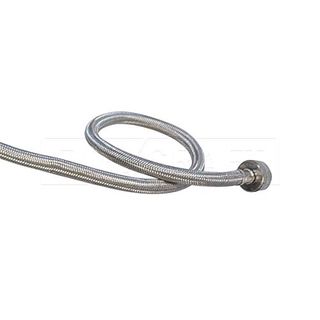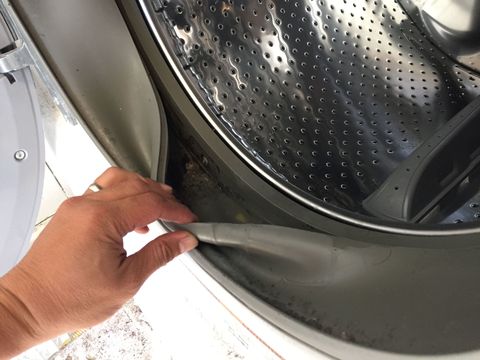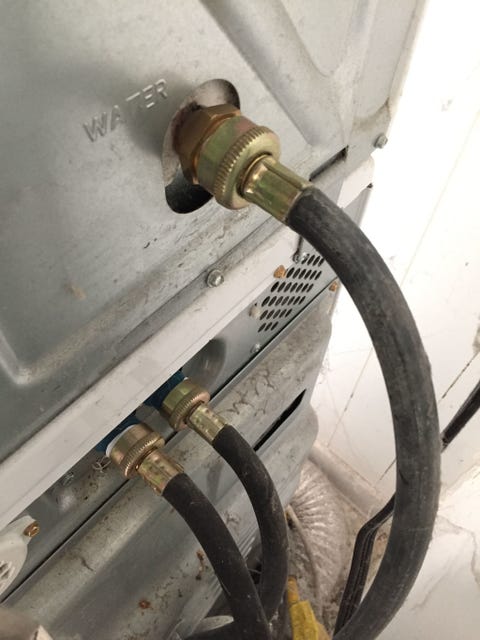How To Clean Water Filter In Samsung Washing Machine
I know what you're thinking: Clean my washing machine? Well, crazy as it may seem, even a machine that washes needs washing every once in a while.
➡ Get the best DIY plans, how-to tips, and unlimited access to the world of Pop Mech, NOW.
First, regular washing-machine maintenance will help prevent the buildup of mold, mildew, dust, dirt, and soap deposits, which can be harmful to your health and clothing—and cause quite a stink, too. Cleaning is especially important for front-loading machines because the rubber gasket around the door remains wet. If you own a front loader, after each load of laundry, use a cotton cloth to dry the inside of the door and its rubber gasket.
Also, keep the door—or lid on top-loaders—open to allow air to circulate. Some front-loaders have a latch, called a magnetic door plunge, that holds the door open an inch or so. If your machine has such a latch, use it to air out the tub. And if your washing machine doesn't have a latch, buy an after-market latch, such as the Door-Doc, that'll work on most machines.

Good Grips Deep Clean Brush Set


Washing Machine Hose Connector

Washing Machine Cleaner
Clorox
Regardless of what kind of washing machine you have, once every three months, run it empty (no clothes) with hot water and one cup of oxygen bleach to sanitize and refreshen the inside of the machine.
Okay, now let's take a look at some other ways to give your washing machine a proper cleaning to prevent the buildup of fungus and grime.
This content is imported from {embed-name}. You may be able to find the same content in another format, or you may be able to find more information, at their web site.
Cleaning Tablets
Many new high-efficiency washing machines have a cleaning mode that's designed to wash a load of laundry using a special cleaning tablet or liquid, thereby washing the machine and clothes at the same time. Products like Affresh Washing Machine Cleaner or Clorox Washing Machine Cleaner can be used once a month, but you shouldn't rely on these products alone.
While a monthly cleaning of your washer will certainly help, the following steps should also be taken to go beyond using a cleaning product, and some of them are a bit cheaper than shelling out for special tablets or liquids.
Natural Cleaners
Vinegar and baking soda are amazing natural cleansers and can be used safely in your washing machine. Add a quart of white vinegar and a cup of baking soda to the cleaning mode and run the washer without clothes. If your washer has an extra soak option, run that to allow the cleaning mixture to really settle into the machine.
Repeat the process again with just water to remove any leftover dirt remnants. Vinegar and baking soda won't sanitize as well as oxygen bleach, but they're much less caustic.
And don't forget to leave the door ajar between washings so the interior of the machine and the door gasket can dry out. Just make sure no curious pets sneak in through the open door.
Scrub the Seal

The rubber seal or gasket around the door will probably be the dirtiest part of your washing machine. Water and moisture can collect there, which creates the perfect environment for breeding mold. Use a soft-bristle nylon brush and the vinegar/baking soda solution to thoroughly scrub and clean the area.
Pull the seal away from the washer as much as possible—be careful not to tear it—so you can clean tough-to-reach spots. If you still see dark spots on the seal after a good scrubbing, the area might be permanently stained with mold. Try scrubbing those spots with oxygen bleach.
And while you can use any nylon brush to clean your washing machine, the narrow type that resembles a giant toothbrush is best for getting into tight spots.
Wash the Tray
Remove and clean the detergent and fabric softener tray, as well as the slot into which it slides. This area can build up gunk over time that will attract dirt, which can clog your washer.
Check the Hoses

Periodically remove the hot- and cold-water supply hoses from the rear of the washing machine and check for any obstructions. There should be a filter in place to catch sand and dirt, which can build up and prevent your washing from getting enough water to function efficiently.
Also, consider replacing rubber hoses with stainless-steel mesh hoses, which are much stronger, more durable and less likely to burst. And speaking of bursting hoses, remember to turn off the valves to both the hot- and cold-water hoses when leaving your home for an extended period of time; say, more than a week. That way, should a hose burst while you're away, you won't return to a flooded home.
Watch This:
Joseph Truini Joe is a former carpenter and cabinetmaker who writes extensively about remodeling, woodworking, and tool techniques.
This content is created and maintained by a third party, and imported onto this page to help users provide their email addresses. You may be able to find more information about this and similar content at piano.io
How To Clean Water Filter In Samsung Washing Machine
Source: https://www.popularmechanics.com/home/interior-projects/how-to/a23624/how-to-clean-washing-machine/
Posted by: saxontiontems.blogspot.com

0 Response to "How To Clean Water Filter In Samsung Washing Machine"
Post a Comment